Courses by Software
Courses by Semester
Courses by Domain
Tool-focused Courses
Machine learning
POPULAR COURSES
Success Stories
Assignment 7-Side Pole Crash Simulation Challenge
AIM: To perform the crash on the Side body of the car to a pole and analysis where stresses are working on it. OBJECTIVES:Side Body-BIW1. Checking the unit system and either following [Mg mm s] or [Kg mm ms].2. Creating appropriate interface, friction 0.2 and recommended parameters.3. There should be no penetrations…
MD SUBHAN
updated on 07 Jul 2023
AIM: To perform the crash on the Side body of the car to a pole and analysis where stresses are working on it.
OBJECTIVES:
Side Body-BIW
1. Checking the unit system and either following [Mg mm s] or [Kg mm ms].
2. Creating appropriate interface, friction 0.2 and recommended parameters.
3. There should be no penetrations and intersections.
4. Creating a rigid pole with friction 0.1.
5. Adding masses to reach target weight 700kg while getting CG about the required range.
6. Adding Initial velocity 20 mph.
7. Running a model checker to ensure good quality.
8. Time-step: 0.5 to 0.1 microseconds.
9. Running 80 ms.
Output requests:
1. Sectional force in the cross member.
2. Intrusion at B pillar, hinge pillar and fuel tank region. Providing recommendations on what can help to reduce Fuel tank intrusion.
3. Peak velocity of inner node of the door.
ABSTRACT : In this project we are about to see the impact of the side body of the car when it hits to the pole, Side body is consist of two side doors with plastic body of arm rest in the windows with electric control panel one for driven and another for passenger, Here we will see that the impact on the side door,hinge, middle pillar,area near to fuel tank, section 1 and section 2 after it hit to the pole.
PROCEDURE:
1. Checking the unit system and either following [Mg mm s] or [Kg mm ms].
STEP 1: Open the starter file neon_side_reduced_000.rad file, go to-
*Menu bar>file>import>solver desk>select .rad file>import
STEP 2: Checking unit system of the model
*Model browser>cards>begin card
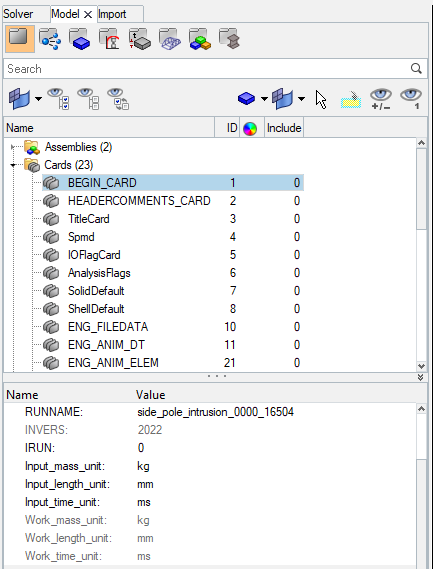
2. Creating appropriate interface, friction 0.2 and recommended parameters.
*Model browser>groups>create group>
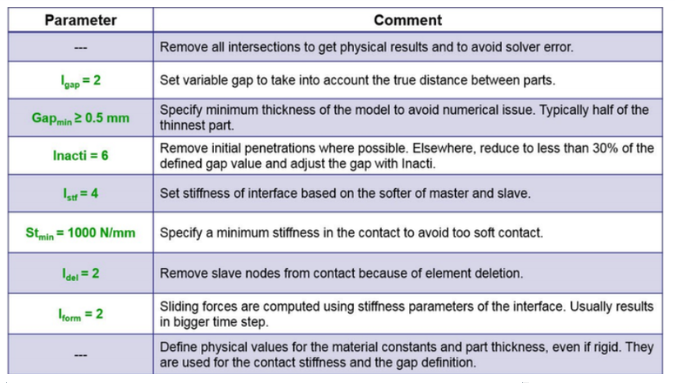
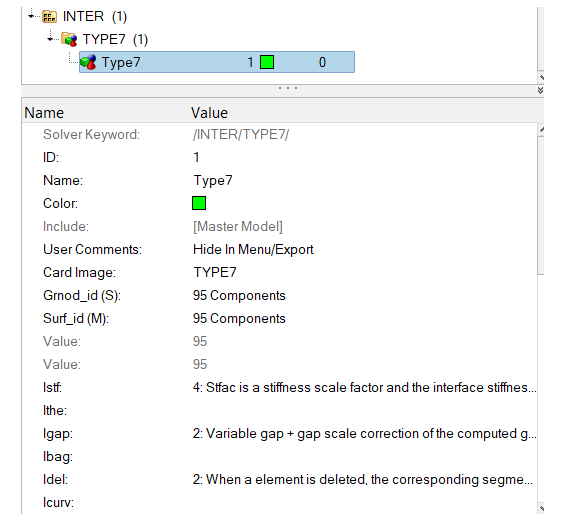
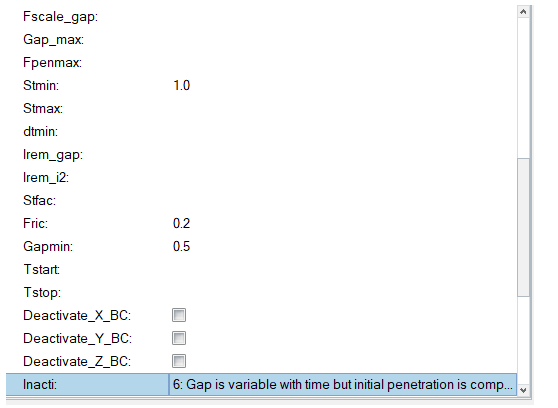
3. Make sure of no penetration and intersections.
1. To check for penetrations in the model, we will go to Toolsmenu on Menu bar and click on Penetration Checkoption. In Penetration check panel, we will select all the components and click on Check command. The software will check for penetrations and then display the results as shown below.
2.There should be no penetrations and intersections
*Menubar>penetration check>select group>check
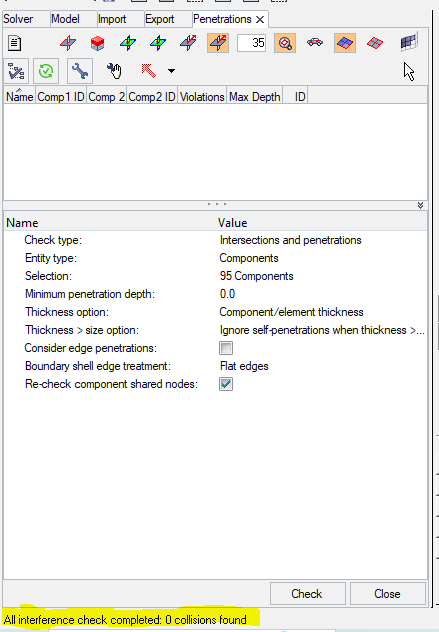
There are no penetration or intersection error found.
4. Create a rigid wall with friction 0.1 as per the reference model.
To create a cylindrical rigid wall at the left side of the car, we will need the outermost node at the front left door of the car. So we will create the outermost node on the element edge using temp nodes option. Then we will right click in solver browser and navigate to Create > RWALL > CYL. In the RWALL panel, under Engineering data we will specify the coordinates of the pole which will be at some distance from the outermost node on side door. Then we will give the normal direction to the pole in Z-axis and diameter of the pole to be 254 mm. The FRIC value will be 0.1 and Dsearch value will be 1000 as shown below.
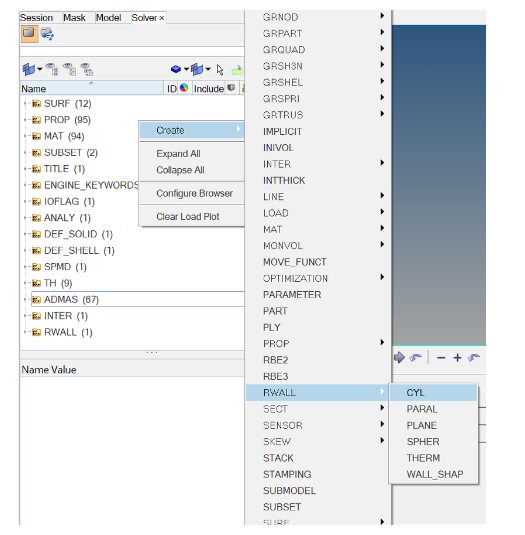
In the RWALL panel, under Engineering data we will specify the coordinates of the pole which will be at some distance from the outermost node on side door. Then we will give the normal direction to the pole in Z-axis and diameter of the pole to be 254 mm. The FRIC value will be 0.1 and Dsearch value will be 1000 as shown below.
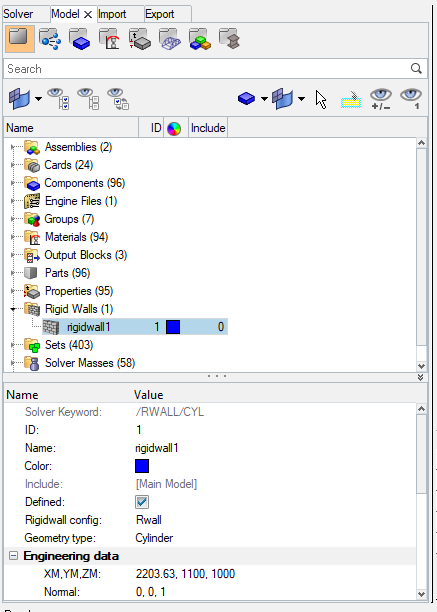
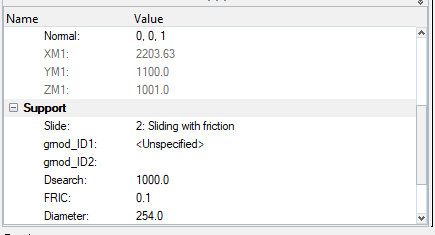
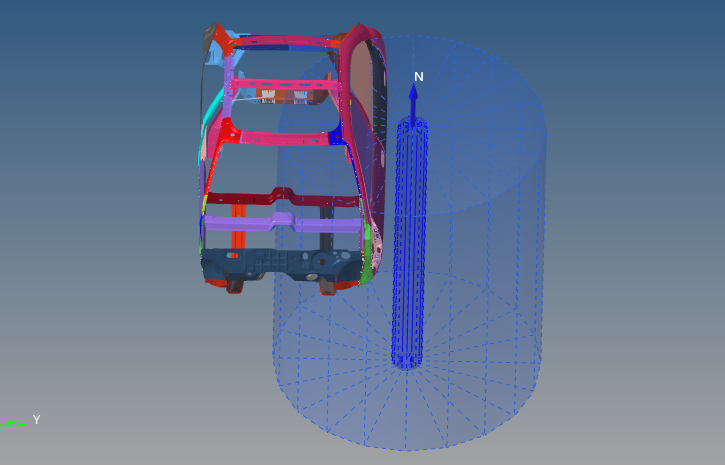
5. Compare the model weight with the reference model and use added masses to reach the target weight of 700kg while getting CG about the required range.
First we have to know about mass of model that is how much mass the model currently holds along with this we need to know about its cog as well to know this goto to>> mass details >> mass cog inertia.
First we have to know about mass of model that is how much mass the model currently holds along with this we need to know about its cog as well to know this goto to>> mass details >> mass cog inertia.
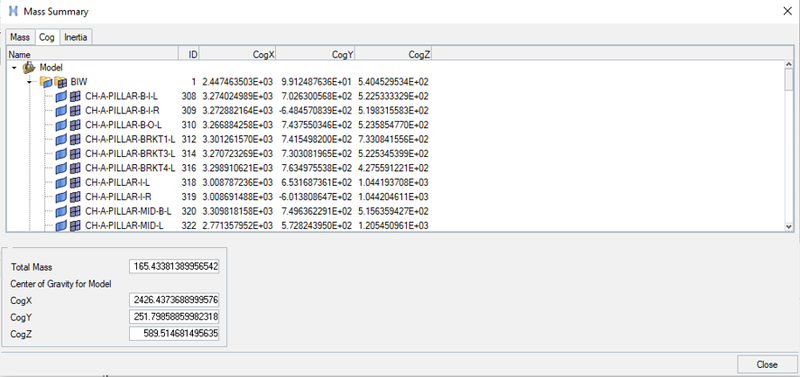
Here the model has some mass of around 166 kg already assign to it , now we have to add some mass to this model so that this model reach to 700 kg and we can get cog of the model to appropriate location.
Similarly we can know cog location of the model by clicking cog window near the mass window shows co ordinate of the current cog of the model by these co ordinate we can create a node from geometery >> node.
After checking this we can add mass in the model from solver >> create >> admas
Select mass type as mass added at each node of the node group. And select appropriate node on logical position.
_1688568865.png)
Once mass is been added it will show centre of mass , now we have to check cog of the model after weight is been added ,check the cog location and create a node at this location.

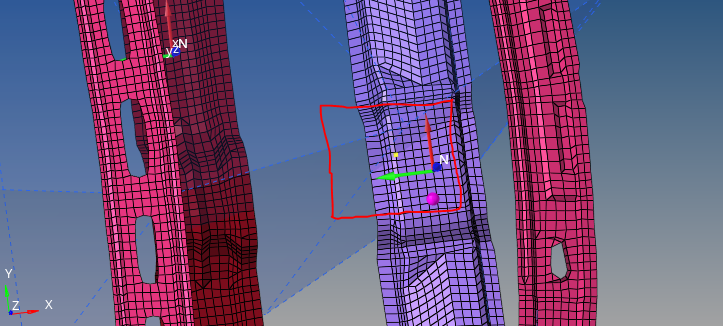
6. Initial velocity 20 mph.
To apply initial velocity of 35 mph we need to first change its units as we are using kg mm ms unit system , to know about its equivalent value in mm/ms we have used consistent unit data as below.
Now that we know its equivalent value we have to create invel card , to create it go to solver deck >> right click >> create >>boundary conditions>>invel.
The definition of invel card will be as shown below.
7. Timestep :0.5 to 0.1 microseconds.
Time-step :0.5 to 0.1 microseconds and Run 80 ms.
- The run time is kept to be 80ms;

Time-step :0.5 to 0.1 microseconds.
- A type of time step option is “INTER” and time step control “DEL” is used.
- We have to keep 0.67 as time scale factor and 0.0005 as a minimum time step control.
- If time step gets reduced below the minimum time step, then this algorithm will add some mass to the element which leads to maintain time step more than minimum time step.

This method is used in order to control the time step.
- A type of time step option is “NODA” and time step control type “CST” is used.
- In order to create ENG_DT_NODA we have to follow steps as explained below.

This method is used to control the time step from the nodes.
Output request :
Condition 1: sectional force in the cross member.
Here we have to find forces passing through cross members to do so we need to create an output request
To perform output request we have to follow the procedure that is for sectional force output request we need section to be created and for section we need frame
To create frame follow below procedure.
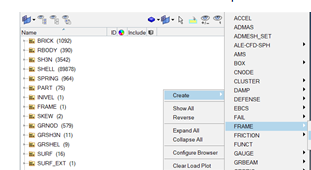
A frame panel will appear in that we have to choose three nodes to define frame these three nodes will be origin , node for x from origin & third node to define xy plane
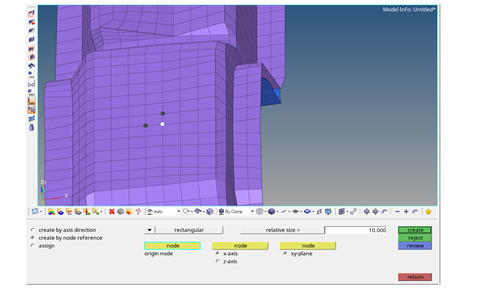
Once created frame will appear as below .
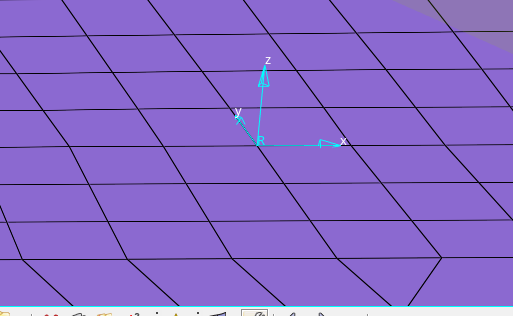
First we have to create GRSHEL card by selecting elements as shown in picture below.
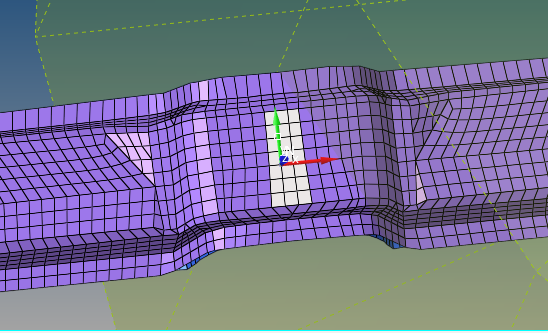
After frame has been done we can we have to create cross section for that go to solver browser create >> sect >> sect
This will brought a cross section property section ,here we have to select nodes for cross section to do so select node respective to n1,n2,n3 >> in sub panel click on node and pick node for respective node >> proceed
Now select frame for property for that click on system near frame >> in sub panel click on system >> pick the frame for system>> proceed.
The frame will be for reference of the section.
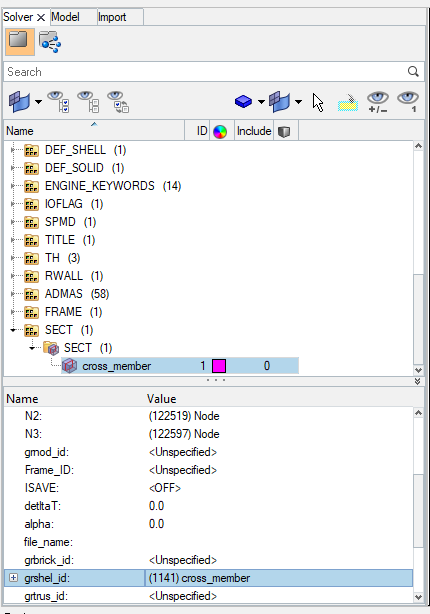
After element selection do proceed it will create section , similarly create section on another cross member.
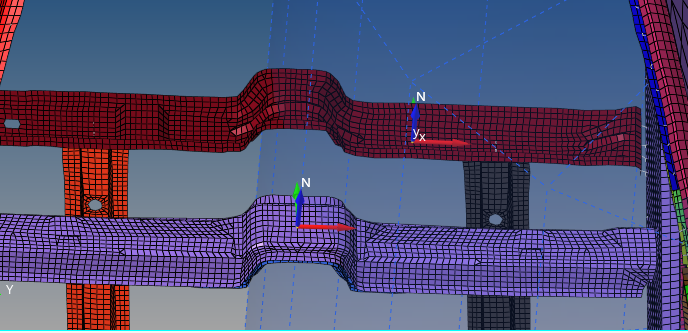
Once section creation is been done we need to create output request for both of them respectively
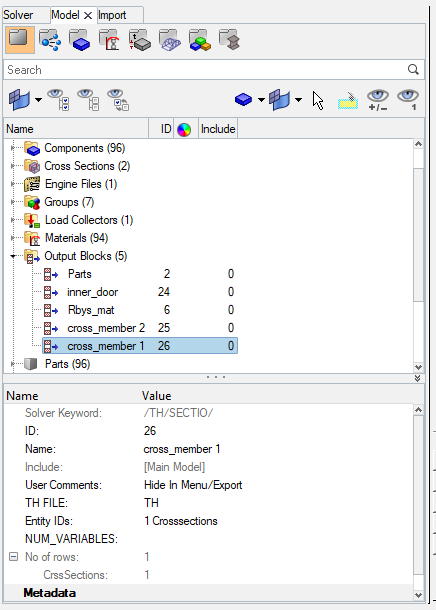
Intrusion at B pillar,hinge pillar and fuel tank region. Provide recommendations on what can help to reduce Fuel tank intrusion.
Here, we need to find the intrusions at B-pillar, hinge pillar and fuel tank. So to find the results at the specified parts, we need to have a frame of reference. Thus we will create moving frames at the opposite side which are at right B-pillar, hinge pillar right side and fuel tank opposite side as shown below.
1. Intrusion at Fuel tank
_1688570227.png)
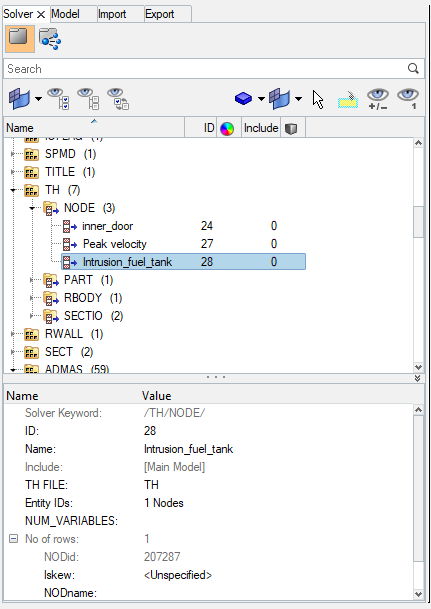
2. Intrusion at B Pillar
_1688577051.png)
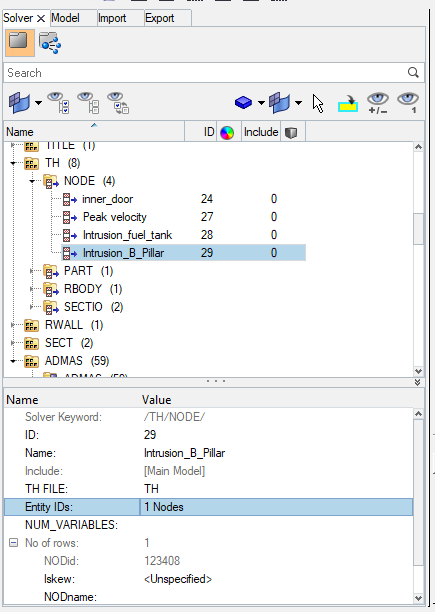
Peak velocity of inner node of the door.
To find peak velocity at the inner node of the door, we will create a moving frame at the node location by using the same procedure as we used in cross section creation. Then we will create output block for the peak velocity by specifying the node and the frame or skew based on which the peak velocity is calculated as shown below.
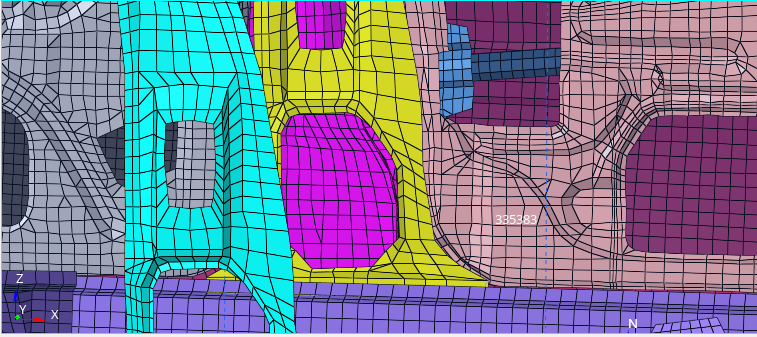
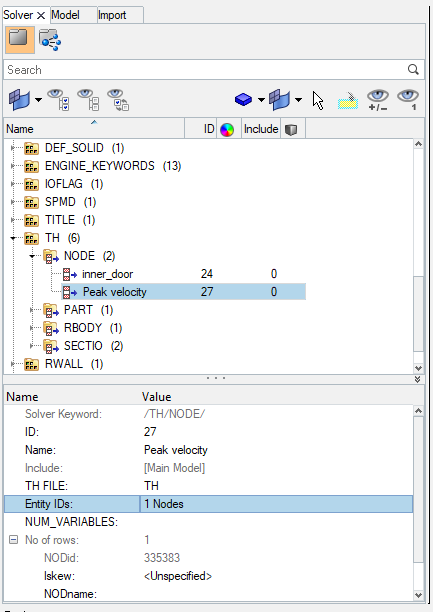
Run the analysis :
Analysis >> radioss >> input file : (file location)-save as >> check the include connectors>>option: -nt 4>> hit radioss.

The tool to review the simulation are available on hyper view
Hyperview is a post-processing and visualization environment for fea that gives the output of analysis in the simulations format that is user friendly to understand
From the simulation, we can review how the impact force acts and cause deformation and point of rupture on the model.
We have to import the animation file in hyperview
Hyperview>>first_run.h3d>> apply.
Simulation in Hyperview:
Animation of the crash simulation is as follows:
Displacement contour plot :-
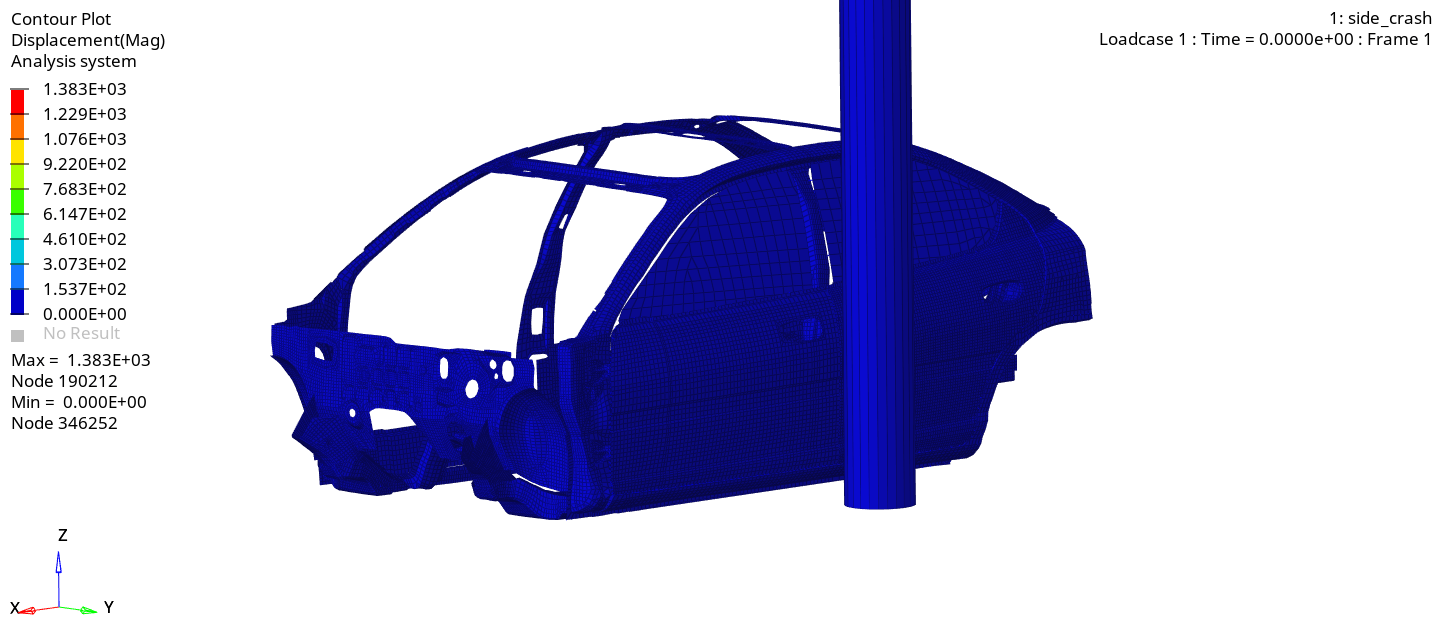
In the above crash simulation of the vehicle, we can see the vehicle body is impacting on a Pole. After the impact, the frame of the vehicle deforms and the vehicle body gets contracted around the pole with left B-Pillar as the pivot point. The CG of the vehicle is in the same axis or direction of the pole, so we can see even deformation of the frame around the pole.
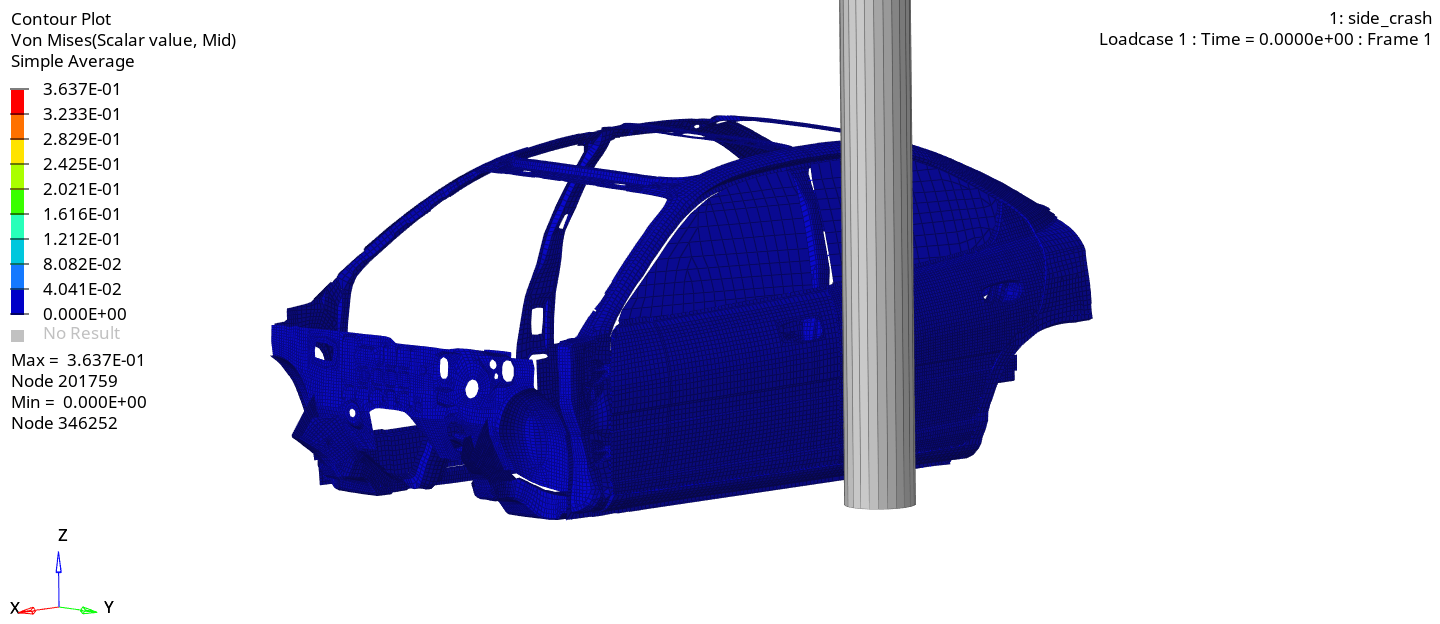
the stress is more in B-pillar and cross members as B-pillar takes the initial impact and then the impact is transferred to the cross members.
Plots in Hyperview 2D :
Hypergraph 2d >>data file : t01 file >>choose the graph which you want as shown in below picture >> apply.
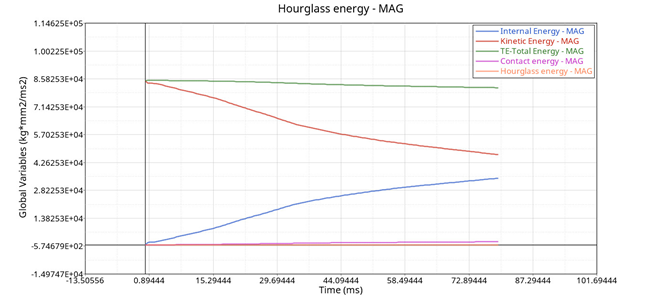
The internal energy and kinematic energy :
Internal energy is nothing but the heat of the system and energy that component has absorbed . When the kinematic energy is decreases, the energy absorbed by the system increases i.e we all know that energy nirtether be created nor be destroyed . Once the vehicle is moving with certain velocity (15.646 mm/ms for the model ),the initial kinetic energy will be high (refer to above graph ). Once the car is hit by the rigid wall , the vehice starts deforming results in absorbing the energy and stored it . Thus, internal energy starts increasing at the maximum deformation, the velocity will become zero and thus the kinetic energy will also be dropping down to zero resulting there is no energy to absorb in the system . Thus , the internal energy remains constant therafter
Once after the simulation , the maximum kinetic energy is found at t=0 ms is 84956.88 kn/mm and minimum at t=79.5 ms is 46735.144 kn/mm
For internal energy at t=0 ms is 0.0 kn /mm and at t=79.5 ms is 34537.156 kn/mm
Contact energy and hourglass energy
From the above graph,we can see that the hourglass energy is almost negligible since we have used improved integrated element formation (qeph)
Ideally, all of kE should be converted into IE and the total energy must remain constant, but in our case, since we have hourglass energy error, our total energy is decreasing. We can rectify this hourglass energy by further reducing the timestep of the simulation and giving the ideal properties wherever we can. Our requirement from an ideal simulation is that we have minimal contact energy and maximum energy absorption/deformation in the elements. We can check the energy error in the engine output file, which has maxed out at -1.7 % which is within the limits for it to be. Our mass error is also 0.1759e-01 which means that the solver did not need to add mass onto the nodes to reduce the timestep to further avoid the hourglass error.
Contact energy is nothing but the opposite energy generated from the system to avoid penetration. To avoid penetration, we have determined the gap min value to 0.5. When the car is moving with a velocity of 35mph and hits the rigid wall, it starts deformation at the bumper section and hence the penetration of the elements occurs and thus the opposite reaction force also exerted in order to avoid the penetration. Hence the contact energy increases gradually from zero. The maximum contact energy found is 1677.25 kn/mm at t-79.5ms.
Peak velocity:
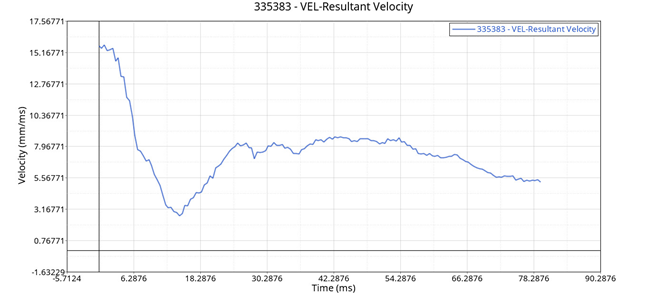
As we all know that when the car hits the pole first impact will be the door and due to the deformation, the inner portion of the door might hit the passengers inside the car and lead to injuries. Hence it is important that the peak velocity at the door region is to be calculated.
From the graph, the peak velocity of the node on the door is 15.64 m/s. As we seen from above graph there is fluctuations in the shock waves this is because of vibration that occurred during the crash of the vehicle.
Cross-sections:
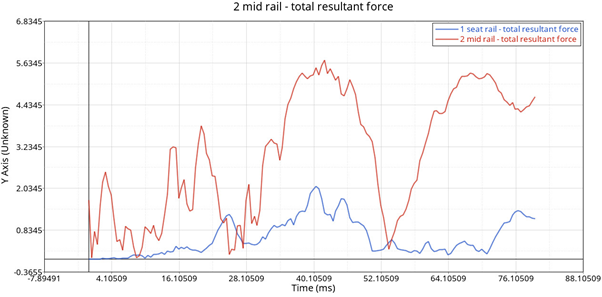
The cross members are the parts that transfer the force from one side to another side when the impact occurs.
The max section force at the mid rail is 5.70 kn and for the driver cross member is 2.10 kn.
When the car hits the rigid pole, the force is transferred from the b pillar to cross members and then to the other side. In the above graph, we can see a rise in curves this is due to the force acting on the cross members. Due to this force the cross members get bent, and the force passing through the cross members get reduced that is why we see the drop in resultant force in the graph. Even though it drops, it won't come to zero.
Learning outcome
- Learned how to set up a side crash test.
- Learned how the rigid wall interface works and can lead to incompatible kinematic conditions.
- Learned how sectional forces are generated.
- Learned how the distribution of forces among the components during a side crash.
- Learned how some components are designed to deform in such a way to ensure the safety of the passengers inside the cabin.
- Learned how to check for energy, mass, and momentum balance.
- Learned how to debugging errors in order to get the right results.
- Learned how to place a node to see his peak velocity.
Conclusion:
The given model was simulated for the side crash using radioss and the results obtained were validated. The graphical results were plotted for all the test cases. From the simulation, it can be observed that there was maximum deformation in the cabin, and also maximum intrusion was found in the cabin area. This is due to the limited number of nodes in the student version some of the biw, engine blocks, suspension system, etc are removed, so the results are not as in real condition. After understanding these we will get to know what all things we should do on this car to make it safer. For example to decrease the amount of intrusion in the fuel tank region we can introduce a cross member there.
Leave a comment
Thanks for choosing to leave a comment. Please keep in mind that all the comments are moderated as per our comment policy, and your email will not be published for privacy reasons. Please leave a personal & meaningful conversation.
Other comments...
Be the first to add a comment
Read more Projects by MD SUBHAN (22)
Assignment 7-Side Pole Crash Simulation Challenge
AIM: To perform the crash on the Side body of the car to a pole and analysis where stresses are working on it. OBJECTIVES:Side Body-BIW1. Checking the unit system and either following [Mg mm s] or [Kg mm ms].2. Creating appropriate interface, friction 0.2 and recommended parameters.3. There should be no penetrations…
07 Jul 2023 03:29 PM IST
Assignment 6-Frontal Crash Simulation Challenge
Frontal Crash test AIM: Frontal car crash simulation of Dodge Neon BIW using RADIOSS solver and Preprocessing using HyperMesh / HyperCrash. OBJECTIVE: The following are the requirements for this project: Set the model of the Neon Dodge ie, the FEA model, so that the required output requests can be post-processed from it. …
02 Jul 2023 07:48 PM IST
Assignment 5-RADIOSS Interfaces & Study of Effect of Notches Challenge
AIM: To study the RADIOSS Interfaces and the effect of notches using Hypermesh, Hyperview and Hypergraph 2D. OBJECTIVES OF THE PROJECT: To create mesh for bumper assembly, mesh element size is 6mm. To apply and study the different cases for the crash tube model. To study the effect of notches on the crash tube. To plot…
25 Jun 2023 09:25 PM IST
Assignment 4-RADIOSS Material Laws Challenge
AIM: To run crash analysis on the given model by applying different materials laws available in Radioss and post-process the results Objective: To carry out simulations of the given starter files and compare the results. There shall be 7 cases (according to given parameters) and they are to be compared primarily via animations…
20 Jun 2023 08:27 PM IST
Related Courses
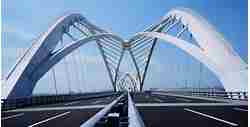
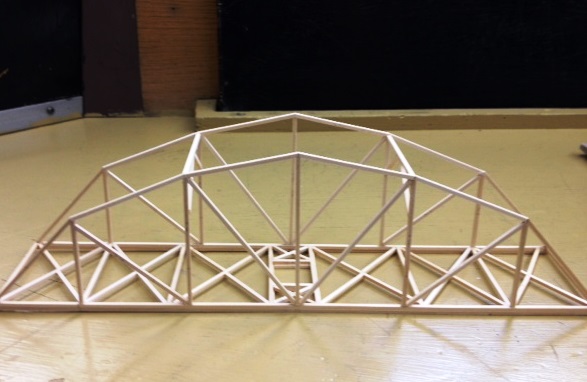
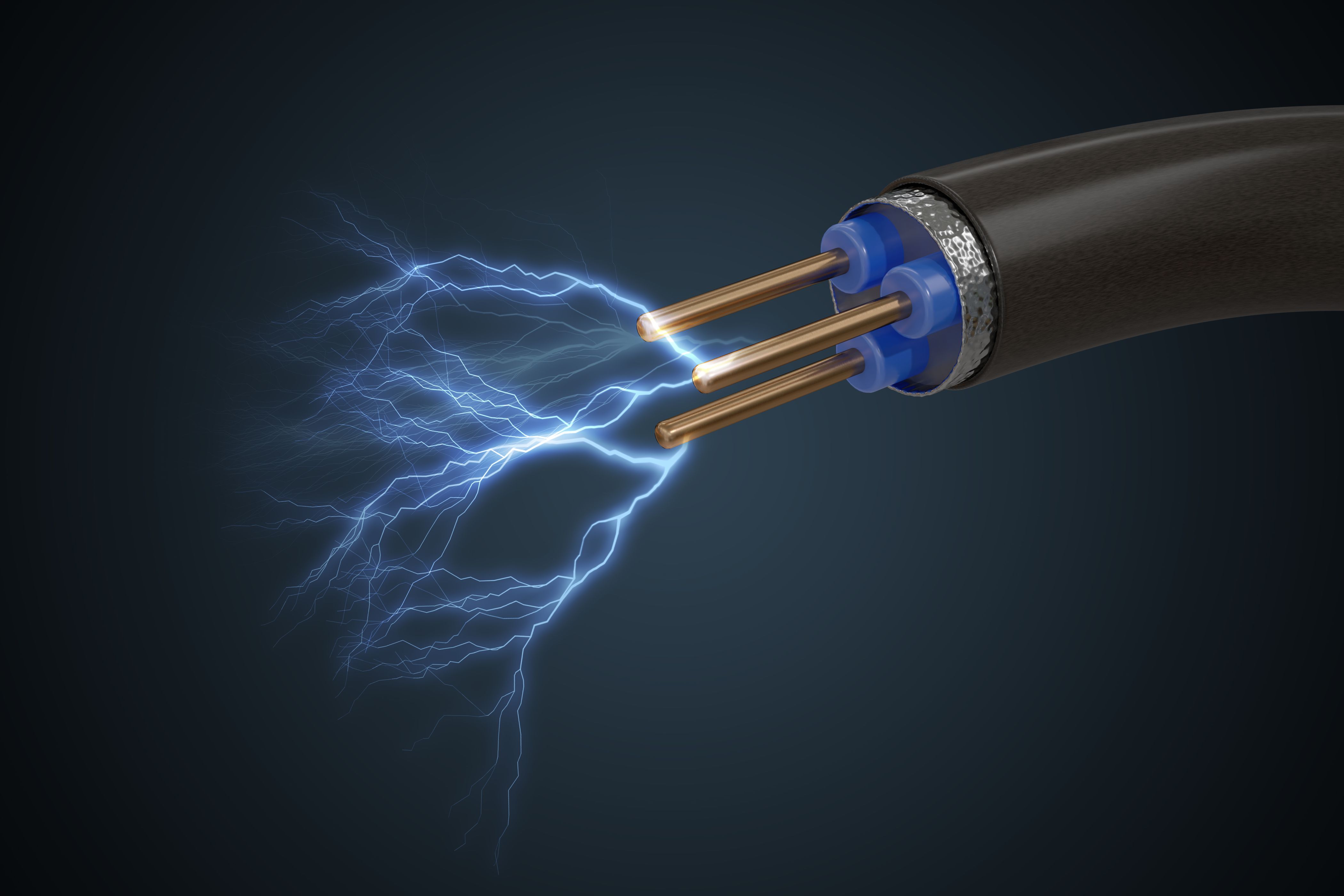
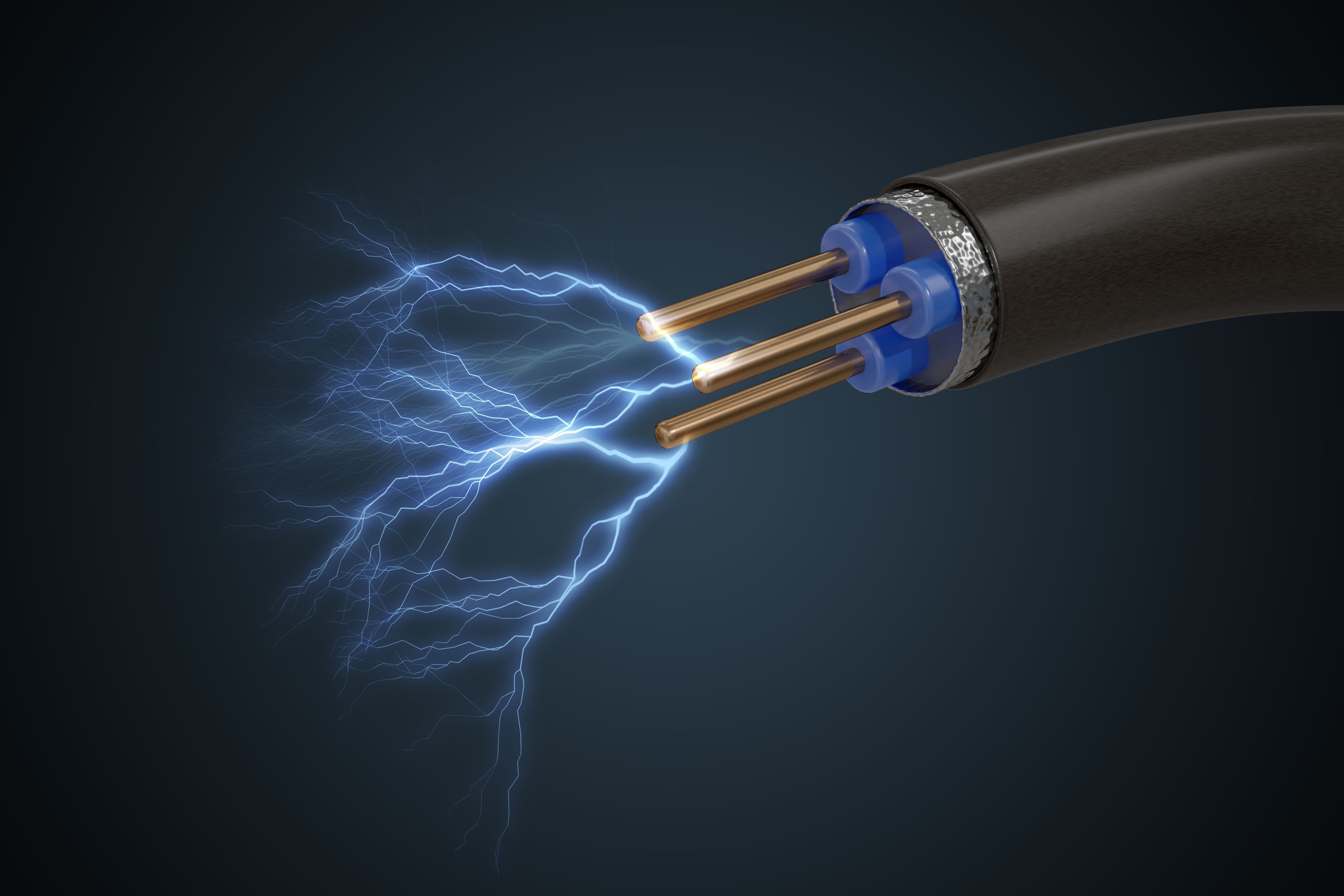


0 Hours of Content

Skill-Lync offers industry relevant advanced engineering courses for engineering students by partnering with industry experts.
Our Company
4th Floor, BLOCK-B, Velachery - Tambaram Main Rd, Ram Nagar South, Madipakkam, Chennai, Tamil Nadu 600042.
Top Individual Courses
Top PG Programs
Skill-Lync Plus
Trending Blogs
© 2025 Skill-Lync Inc. All Rights Reserved.








